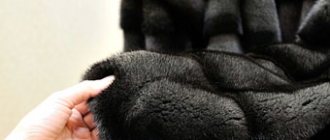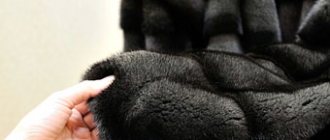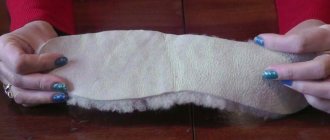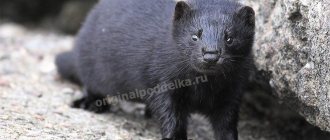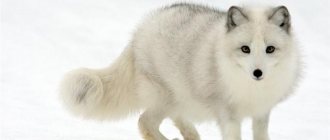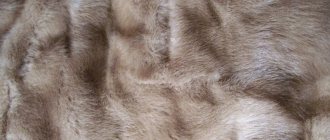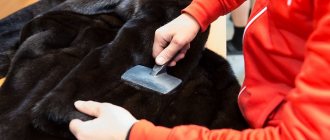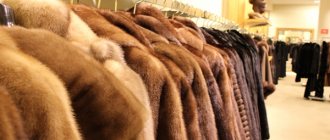In cold weather, cozy, fashionable fur adorns our clothes - they are used to trim coat collars, hoods, hats and even shoes. Some people prefer completely fur outfits - fur coats, coats, vests.
The material differs in color, texture, cost and many other characteristics, but there are only two main types. And the question in this regard is eternal: how to distinguish natural fur from artificial fur. It is important to have an answer to this in order to correctly determine how to care for an item and fairly evaluate fur products when selling or buying. Also, knowing the “topic” will protect you from scammers and protect you from losing money.
After reading our article and looking at the photo, you will easily find out which fur is natural or synthetic, and will avoid many problems.
Where to buy
You can buy a fur product in a specialized store or company showroom. Here, all samples will be accompanied by quality certificates and a guarantee. So you don’t have to doubt the authenticity of the fur. However, in such a place you will overpay for the brand.
You can make a cheaper purchase at a clothing market or small shops. In this case, it is better to contact those who have been in this business for several years and have established themselves as a reliable seller.
Label
Particular attention must be paid to the label and the information contained on it. If you don’t know how to distinguish faux fur from natural fur, at least read what the manufacturer indicated. All information about the composition of the fur, its origin must be indicated, the features of using the product, as well as the subtleties of caring for them must be reflected. The absence of a label should be a red flag. In 2010, a document was adopted in the Russian Federation obliging manufacturers of fur products to provide complete and reliable information about the materials used.
Features of real fur
No matter how much the seller praises his product, it is still better to see for yourself its quality.
- Today we have learned to produce synthetic fur of excellent quality, which is hardly distinguishable from the real thing. Run your hand through the fur. It should be smooth and tender to the touch, but at the same time dense. It's like ironing silk fabric.
- Crumple the edge of the product. The area that has easily restored its shape will indicate the authenticity of the fur.
- Smell the product. It should smell like tanned leather, but not like paint or synthetics.
- Under the lining there should be a stamp from the manufacturer of the product with information about the origin of the fur.
By the way, read this article too: How to distinguish original Thrasher items from fakes
How to distinguish real fur from artificial fur
All manufacturers tend to want to reduce the cost of producing their products as much as possible in order to obtain maximum profits. This desire has not bypassed the global fur industry. Increasingly, fur factories are trying to pass off artificial material as its natural counterpart, and with the development of technology, the substitution is becoming more and more difficult to determine.
Natural fur retains heat much better than all other materials, and the replacement will make itself felt already at the first good frost. However, how to recognize it at the stage of product selection? Only a few fur hat stores are guaranteed to use only natural fur, which has excellent heat-saving properties. For all other retail outlets, you should take on board a few simple tips from fur specialists that will allow you to accurately recognize an artificial fur substitute.
Sign one
First of all, you should pay attention to the product tag, because most often natural fur is bought in the form of clothing, headwear or accessories, and all of them must have a label with comprehensive information about the composition of the material, its origin and the manufacturer. In addition, manufacturers often provide information about product care and cleaning tips. However, the sewn-on label is not always true, so if the question is Where to buy a fur hat? - then it’s better to immediately turn to professionals, such as the Fair of Caps factory. On our website you can easily find the most fashionable and pleasant new thing, both for yourself and for your loved ones.
Sign two
Another sign of natural fur is the weight of the product; it will always be a little more than that of a similar model made of artificial material. Real skins of fur-bearing animals cannot be cheap, so pay attention to the price, if it is not too high compared to products of this class - you should take a closer look at it.
Tactile sensations will help in identifying a fake: the natural material is soft, smooth to the touch, lies beautifully and plays in the sun, it feels like you are stroking a soft, fluffy animal. At the same time, the synthetic substitute is a little rougher, tougher, and feels like a soft synthetic children's toy.
Main tests
Experienced specialists in the field of fur products recommend carrying out three simple tests that will accurately determine what kind of material you have:
- Fire test. All you need to do is tear out a small piece of wool from the fur base and set it on fire with a lighter. The natural base will quickly burn, releasing the corresponding smell of burning wool, which is quite unpleasant. Synthetics, on the other hand, will practically not burn - it will only melt a little, turning into a dense droplet. At the same time, the smell will be different: burnt rubber.
- Pin test. The natural base of the skin is usually very dense. Therefore, it will be quite difficult to pierce it with a pin or needle, whereas they will enter into synthetic fabric easily and unhindered.
- Basics test. All you need to do is look under the lining or push the dense pile firmly apart with your hands. In an artificial substitute, a dense synthetic, stretchy base will be visible; in a natural analogue, leather will be visible.
It should be remembered that recently products made from natural materials are becoming increasingly rare, because they are expensive and require more careful care. But artificial fur is becoming more and more perfect, and it is becoming increasingly difficult to distinguish it from the natural skins of fur-bearing animals. Therefore, when purchasing natural fur, you should be as careful as possible and use the above recommendations.
Distinguishing fur
It often happens that the fur seems to be natural, but not from the animal that the seller insists on. In order not to buy cheap fur for crazy money, remember the following:
- – mink fur can be replaced with the fur of a rabbit, marmot or steppe mink. Real mink fur feels like oil and has a dense, even pile. Its hairs are of equal length, with a soft undercoat. Each villi tapers from root to tip. Mink skins are monochromatic, but the degree of coloring should be different.
- -beaver fur has a dense undercoat. It feels very soft and fluffy. Usually they try to pass it off as nutria fur, which is tougher and shorter.
- -silver fox fur is long and soft to the touch. Each of its fibers includes three shades of color.
The main differences between natural mink
Mink is highly valued in the world of fur products along with lynx and chinchilla. Every woman with refined taste and high demands in life dreams of having such a thing in her wardrobe. The fur of this animal is beautiful and durable, it looks expensive, presentable, and besides, it is really warm. A mink coat is characterized by excellent wear resistance: even in harsh climates, the wear life of the product is at least seven years, and with proper care it doubles. The quality and service life are affected by the age of the fur, what part of the skin is used (from the back of the fur coat is more expensive, from the belly and frontal part - cheaper) and the type of animal (European, American, Scandinavian and others). It is recommended to buy mink coats only in specialized boutiques, where the likelihood of encountering a fake is minimal. But even in a fashion boutique, the product should be carefully inspected and studied before purchasing. There are several criteria by which you can distinguish mink from a fake. It is equally important to be able to distinguish a mink from a rabbit and other animals by their fur. After all, fur is different from fur, and even a natural rabbit costs several times less than mink.
How to identify a real mink coat
A mink coat is the dream of almost every woman. It looks very rich and lasts a long time. Every lady feels like a queen in it. In order for the feeling to be exactly that, it is important to purchase a fur coat from real high-quality mink.
Appearance
Putting the fur coat on a flat surface, let's examine the fur. It should be shiny, monochromatic, with a slight striped pattern and varying color intensities. The color of natural mink is a palette of brown and gray shades, as well as pastel tones from blue to caramel.
Let's touch the fur. It should be hard and elastic, easily return to its original shape, and not prick. The dense undercoat is clearly visible in it, and above it there are guard hairs of the same length. If the fur is not dyed, then you can find white hairs in it.
By the way, read this article too: Canada Goose: how to spot a fake?
Wrong side
As a rule, good manufacturers do not sew the lining to the fur coat. And you can calmly examine its underside. The reverse side of the skin has a light shade (if the fur has not been dyed). It must have a factory seal. Pieces of skins must be at least 15 by 15 cm in size and have the shape of an elongated trapezoid.
It is advisable that they be sewn together rather than glued - this way the fur coat will last longer.
We carefully inspect all seams.
A hemmed lining is a reason to doubt the quality of the item.
Napkin
Run a damp white cloth over the fur. After a natural mink there should be no traces left on it. If they appear, then either the mink is dyed, or it is not mink at all.
Price
As you know, a mink coat costs a lot of money. Therefore, if you are offered a mink product at a cheap price or at a discount, you should think about it. A low price may mean that it is either a fake or the fur of this mink is not of the best quality. The product could have been dyed to hide defects in the pile, or the skins may have been stretched too thin or glued together.
Signs of a high-quality tanned skin
In order to check the quality of a fur coat as thoroughly as possible, you need to know the stages of processing the skin. Its finishing will be ideal only if the work takes place in a production workshop.
Industrially tanned skins undergo numerous technological processes:
- Dried specimens are soaked in a special solution, and after some time they begin to clean the core. How well this process went can be shown by the smell emanating from the fur coat. If the skins are not properly cleaned of fat and muscle fibers, the skins become rotten and smell bad.
- Degreasing is the next step, designed to remove fatty fibers from the flesh. If this is not done, the skin will rattle when shaken.
- The tanning process gives the product strength. When properly tanned, the skin becomes elastic. After this, it will be able to easily restore its shape with any mechanical action.
- When the tannins penetrate into the layers of the dermis, the skin is dried and treated with a fat emulsion, which will allow the dermis to retain the remaining moisture inside the cells.
- After this, the skins are dried, kneaded well using special rollers and separated into varieties. Low-grade skins are dyed.
Technological process of fur processing
When examining a fur coat, the dyed skin can always be distinguished from the original color. The flesh of a fur coat sewn from high quality natural pieces should be white or slightly yellowish. The yellower the skin color, the older the fur, and the less the coat will be worn. Dyed skins are revealed by the color of the skin. It has the same shade as the fur. Finished skins may have defects:
- hair loss;
- scabs;
- yellow hair;
- exposure and destruction of hair roots;
- keratinization of skin tissue;
- rotting due to violation of processing technology.
Poor quality fur may fall out.
All the shortcomings of poor workmanship will appear during use of the finished product. The smell of raw leather indicates the beginning of decomposition of the flesh. This occurs due to a violation of processing technology, which leads to rapid cell destruction. For this reason, the layers of the skin become very thin and lose their elasticity.
Distinctive features of different types of mink
Depending on the origin (where the animal was raised), mink fur has a number of distinctive characteristics.
Thus, Russian mink is found mainly in long coats. The fur looks slightly shaggy, but has a natural shine and is silky to the touch. The pile is quite long and the undercoat is high. This fur coat is very warm, it can withstand any frost, warming its owner. You can distinguish it from a fake by the height of the middle layer of wool, which is significantly higher than the down. The Belarusian and Baltic species have the same characteristics as the Russian, although they are grown in other regions.
The most popular type of this fur animal is the Scandinavian one. This type is grown in Finland and Scandinavia. Depending on this, the fur can be low or high, but the undercoat is always very thick. There is another Scandinavian type of this animal, the so-called “polar”. Visually, this fur is more reminiscent of sable, since the pile is long, brown, and quite expensive. It is very warm, waterproof and has a wide range of colors (various shades of dark brown, up to black brown).
The North American species is represented exclusively by black fur. This fur is considered the most expensive, it is of impeccable quality, its underfur is very thick and dense. The pile in such products has a beautiful appearance, it is low and silky, in many ways reminiscent of velvet.
The most affordable in terms of pricing policy is Chinese mink fur. He has a long pile and a thick undercoat. Due to its high popularity, it is extremely rare to find original Chinese fur; fakes are becoming more and more common. All products are cut and can be dyed.
Check your fur coat by chip number
From August 2021, all fur products are subject to mandatory chipping - application of the KIZ (Control Identification Mark). The chip contains complete information about the movement of the skin, fur coat, finishing method, etc. Selling fur products without a chip is a criminal offense. Therefore, the presence of a chip is a mandatory condition when selling fur coats. Absolutely all types of furs are marked. Exceptions are fur products that are used for collars, shoes, hats, toys, and mittens.
KiZ is available in three versions, two sizes (rectangular, square) and two color variations.
What are the types of chips - KiZ.
Red color is used on products imported from other countries. Green for things produced in Russia.
The chip is checked on the Chestny ZNAK website, online here. You can also download applications for phones there. Install the app and scan the code directly in the store using your phone.
Another interesting way to check the authenticity of mink fur
If we wrap a real mink coat around our fist, the undercoat will create the feeling of a single flowing stream. At the same time, the groundhog will have a clear transition: the fur will lie beautifully at the edges and stick out in the middle. In addition, a mink coat always weighs less and when trying it on it may seem like you are wearing nothing at all.
Let's say the fur coat is really made of mink. But why is there such a difference in price? The fact is that many brands invest in advertising and certification of their products. This certification speaks primarily about the quality of the fur product itself. Although, unfortunately, even here replicas have penetrated.
Where to start
Before distinguishing a mink coat from a fake, you need to take into account some nuances.
Mink fur is the highest category. This skin is on par with lynx, chinchilla, and sable. The product is distinguished by increased wear resistance.
The natural mink version of the fur coat is worn for at least 6-8 winters, and can also last about 15 seasons.
Mink is loved for its visual appeal and durability. But the quality differs, as does the price.
One of the main indicators of quality is the age of the animal, the part of the skin used, and the variety. Minks are Scandinavian, American, European, etc.
Different parts are used to make a fur coat. The most expensive ones are made from backs. Cheaper options are made based on bellies and foreheads.
Mink fur is counterfeited with rabbit fur
But it turns out to be much easier to distinguish fake fur than, for example, not coming home wearing a marmot fur coat. The fact is that careless manufacturers pass off the fur of some animals as more expensive. Breeders have bred very cute rabbits - “twins” to chinchillas or the same mink. These long-eared cuties not only become pets, but without even realizing it, they participate in a “conspiracy” against the consumer. What is worth knowing in this case?
In order to bring rabbit fur to its final form, it is plucked in a special way. Therefore, if you look closely, you will see either the fibers are of different lengths, or the underfluffs will be the same length as the main pile - this is just a sign that it has been plucked.
The rabbit sheds more: if you run your hand over a fur coat and it turns into a furry paw, leave this store without hesitation. As for the marmot fur, in the product it looks like a “poorly combed” mink, in a word – somehow disheveled. The fibers of the fur itself are more prickly.
Differences between dyed skins and pure, natural fur
Fur is dyed not only to give it a bright color, but also to hide defects. To distinguish a dyed skin from pure fur, the user must know that:
- The leather base of the product should be beige in color. If it has a different color, then it is a dyed skin.
- Real fur cannot be completely black.
- The appearance of natural fur changes under different lighting conditions.
When buying a fur coat, it is important to know whether it is dyed or not. Because the color of fur affects its quality. Also, such products require special care.
Distinctive characteristics of old fur
A fur coat made from natural fur may also be of poor quality. These are products that are made from old fur. Such an item of clothing will not last long for a girl.
To distinguish old fur from new, you should know the following:
- The leather base of a fur coat made from old fur turns yellow over time.
- The product has a specific smell.
- Over the years, the fur may turn yellow.
Products made from old fur are much worse than outerwear made from new ones. Fur coats that have adorned the counter for a long time quickly lose their elasticity and beauty.
